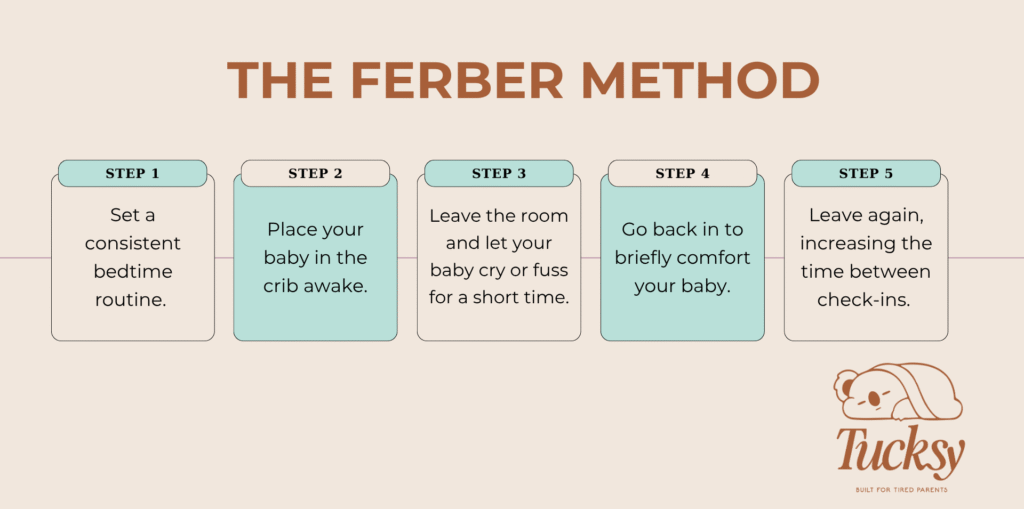What Is the Ferber Method and Is It Right for You?

If you’re exploring sleep training methods, chances are you’ve come across the Ferber Method. Loved by some, questioned by others, and often misunderstood, it’s one of the most talked-about sleep strategies for babies. But what is it really? And more importantly, is it a good fit for your baby and your parenting style? Let’s break it down clearly and honestly.
Table of Contents
What Is the Ferber Method?
The Ferber Method is a form of sleep training that teaches babies to fall asleep on their own. It was developed by Dr. Richard Ferber and is sometimes called “graduated extinction.” That simply means gradually letting your baby learn to self-soothe, while you check in at timed intervals.
It’s not the same as the “cry it out” method where you leave your baby to cry without returning. With the Ferber approach, you still offer reassurance, but you give your baby space to build sleep independence, step by step.
How the Ferber Method Works (Step-by-Step)
Here’s a simplified overview of how the Ferber Method is typically done:
- Set a consistent bedtime routine. This helps signal to your baby that sleep is coming.
- Place your baby in the crib awake. After your routine, lay your baby down while drowsy but still awake.
- Leave the room and let your baby cry or fuss for a short time. You’ll return after a few minutes.
- Go back in to briefly comfort your baby. Keep it short and calm. Avoid picking them up.
- Leave again, increasing the time between check-ins. For example: 3 minutes, then 5 minutes, then 10 minutes, and so on.
These intervals gradually teach your baby to fall asleep without needing help from rocking, feeding, or being held.

When Can You Start the Ferber Method?
Most experts recommend waiting until your baby is at least 4 to 6 months old before starting any form of sleep training. By this stage, babies are often developmentally ready to sleep for longer stretches without feeding.
Your baby should also be:
- Gaining weight steadily
- Able to self-soothe in small ways (like sucking on fingers)
- Falling asleep with your help and waking frequently during the night
Always check with your pediatrician before beginning any sleep training method.
Track your baby’s sleep
Download Tucksy’s free Sleep Tracker & Milestone Map (0–24 Months) to see what’s typical by age.
How Long Does the Ferber Method Take to Work?
Many families notice significant changes in their baby’s sleep patterns within 3 to 7 nights. While some infants adapt quickly, others might need a bit more time to acclimate. Maintaining consistency is crucial; frequently starting and stopping or altering your approach can confuse and distress your baby. A calm and steady method not only aids in their adjustment but also creates a more peaceful environment for the whole family. Remember, patience is essential, as every baby has their unique timeline for adapting to new routines. Consistent reassurance can foster comfort and security during this transition.
Is the Ferber Method Right for You?
This depends on your baby’s temperament and your comfort level. The Ferber Method can be very effective for families looking to establish independent sleep and reduce night wakings.
It may be a good fit if:
- You want a structured, predictable sleep plan
- Your baby is not responding well to gentle settling methods
- You can tolerate some crying while knowing your baby is safe and loved
It might not be the right time if:
- Your baby is going through a regression, illness, or major transition
- You feel deeply uncomfortable hearing your baby cry
- You prefer a more gradual or responsive approach
There is no one-size-fits-all answer. You know your baby best.
Does the Ferber Method Harm Babies?
There is no scientific evidence that the Ferber Method causes long-term harm. Studies have shown that babies who learn to self-soothe using timed check-ins do not have increased anxiety, attachment issues, or developmental delays later in life.
That said, all babies are different. What matters most is how you support your baby during the day and how consistent and loving your care feels overall. If you respond warmly and meet your baby’s needs, sleep training doesn’t break trust.
Track your baby’s sleep
Download Tucksy’s free Sleep Tracker & Milestone Map (0–24 Months) to see what’s typical by age.
Tips for Success with the Ferber Method
- Pick the right timing. Avoid starting during illness, teething, travel, or big life changes.
- Stick to the plan. Follow the same interval pattern each night.
- Stay calm. Your baby can sense your energy. A calm presence helps them feel secure.
- Keep check-ins brief. Just a few soothing words or a gentle pat is enough.
- Be kind to yourself. This can be hard emotionally. Having a partner or support person nearby helps.
Alternatives to the Ferber Method
If the Ferber Method doesn’t feel right, there are other sleep strategies to consider:
- Pick-Up/Put-Down Method: Gently pick up your baby when they cry, then put them down once they calm.
- Chair Method: Sit next to your baby’s crib and slowly move farther away each night.
- Bedtime Fading: Shift bedtime later to match when your baby naturally falls asleep, then move it earlier gradually.
- No-Cry Sleep Solutions: Focus on routines and gentle fading techniques without allowing crying at all.
There is no wrong choice, only what works best for your baby and your family values.
Learn more on how to sleep train your baby
Conclusion
The Ferber Method can be a helpful, structured path toward better sleep for many families. It works for some and not for others and that’s okay. What matters most is feeling confident, connected, and calm as you guide your baby toward healthier sleep habits.
At Tucksy, we support every family’s path to rest. Whether you try Ferber, a gentler approach, or wait it out entirely, your love is the constant that helps your baby grow strong and sleep better.
Medical Review:
This article was medically reviewed by Dr. Suffyan Rasheed, MBBS, GMC (UK) — a UK-based Paediatrician and Child Health Specialist with over eight years of experience in Paediatrics, Neonatology, and Paediatric Emergency Medicine.